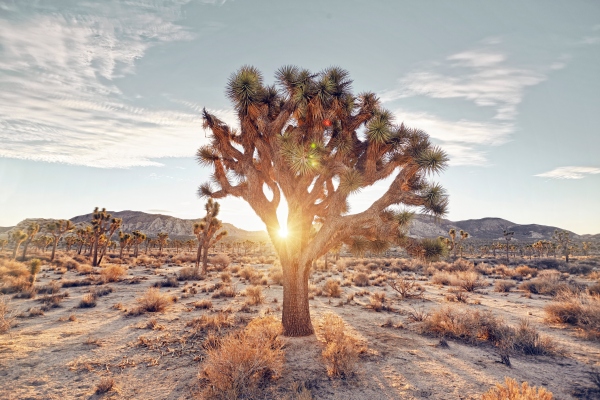Reforestation is one of our best tools to fight the climate crisis. In the tropics, forests have been reported to absorb 10 million metric tons of carbon dioxide every year. A mature tree can absorb about 48 pounds of CO2 per year. In the U.S., our forests store 14% of all annual carbon dioxide emissions, according to the nonprofit American Forests. There is no path to climate-neutral without forests and trees.
Many businesses like Salesforce and Microsoft are funding the planting of trees in wildfire burn scars and agricultural lands. But the stealth-phase startup Undesert is working on a whole new frontier for reforestation.
As you can probably guess from the name, the company is focused on planting trees in deserts, specifically desert shrublands in the Alamogordo region of New Mexico. Nicholas Seet, CEO of Undesert, calls his company “climate triage” — doing something to reduce emissions now while the rest of the world catches up.
But should we be planting trees in the desert?
“There is a current debate about whether drylands are suitable for reforestation for the purpose of global climate mitigation purposes,” said Niall Hanan, professor of dryland ecology in the Plant and Environmental Sciences Department at New Mexico State University.
Seet called the shrublands “underutilized, empty space,” but Hanan stressed that these are valid ancient ecosystems with their own biodiversity, not simply degraded forests. And there’s a reason deserts don’t have trees.
“If [deserts] were suitable for trees they would probably have trees in them,” Hanan said. Trees need sun, CO2 and water to survive. Deserts drastically lack one of those ingredients, preventing most trees from growing naturally. But that’s one problem Undesert has innovated around.
Undesert has tweaked a water desalination technology so it can generate 20 liters of water per 24-hour period and can work with brine water previously too salty for reverse osmosis.
“The problem with [reverse osmosis] technology is it has a lot of waste brine that cannot be filtered anymore,” Seet said. “We can take reverse osmosis brine through our system and then you get pure water and salt.”
Undesert removed bottlenecks from a traditional solar-greenhouse desalination technology where the sun warms a salty pool vaporizing to create pure water that condenses on the roof of the greenhouse. Undesert developed a modular design to capture the water and was able to increase efficiency by five times that of pool evaporation. Instead of condensing on the roof, condensation occurs in a separate chamber cooled by tubing with circulating cool water. In this system more than 93% of the water in the saline is recovered as clean water. The entire process uses solar in a microgrid making the process low in emissions.
Undesert is working with Navajo nations to source for its desalination technology brackish groundwater that has become undrinkable due to salt concentration. The company then uses drip irrigation to supply the desalinated water to Afghan pines, the trees Undesert has decided to use in its reforestation. The company has planted 16 of these trees so far. Undesert chose the Afghan pine because it is desert hardy, requiring little water, and grows fast, tall and straight. The company also has 50 ponderosa pines under its watering system because its rooting system is well adapted to withstand drought. But even if the trees are getting a sufficient amount of water, there are other environmental factors like temperature that can hamper seedling survival.
There is no path to climate-neutral without forests and trees.
According to Undesert, the small demonstration of trees supplied by the solar desalinated water has been operating since September 2021, and are showing healthy development. The area has intense solar energy and available underground saline water. And the Alamogordo region where the demonstration is located is adjacent to the Sacramento Ranger District that has forests of Douglas fir and ponderosa pine and had many more before they were removed for train tracks and maintenance. All these factors give Undesert the confidence that their trees will be a success.
But then there is the scalability. Having an entire irrigation system for a large-scale forest isn’t feasible. And using brackish groundwater might work in New Mexico, but Hanan noted that most deserts aren’t near oceans and don’t have easily accessible groundwater. Cost, labor and maintenance will also quickly add up. Even just the trees can end up costing $1 million per square mile, even if each seedling costs as little as $10, according to Hanan. Most desert inhabitants across the globe do not have access to these types of funds.
And just sourcing seedlings is already a huge problem for reforestation efforts.
“Even getting 400 for the first hectare would likely be difficult,” Hanan wrote in an email. “It is unlikely that the southwest (or even the western US) tree nursery industry could supply the 100,000 seedlings needed per square mile, let alone for any larger area.”
But there are still more questions beyond just the tactical.
“In a severely water-limited place, like the southwestern U.S.,” said Matthew Hurteau, a forest and fire ecology professor at the University of New Mexico, “if you’ve got the technology to fairly inexpensively and in a low carbon way purifying that water, is growing trees in the desert the best use of that water?”
Drawing down carbon emissions and providing co-benefits to local communities by planting trees could be a very valuable use of this water, but experts like Hanan and Hurteau would expect to see a detailed cost-benefit analysis that answers questions like:
- How suitable is this land for trees?
- Are these the right plants?
- Are they native species or exotic species?
- What are they going to do to the existing ecosystems?
- What will be lost by adding trees into these systems?
And will the carbon stored actually be enough to make a dent in our carbon problem? Hanan is skeptical because trees grown in the desert certainly won’t be the huge trees of the tropical rainforest, and will probably have a fraction of the biomass. Trees in the desert probably won’t ever be the lungs of the earth, but can or should they be a tiny inhale in the process?










